|
Dr. Henry Power (c.1626 - 1668) - author of the first book published in English on microscopy in 1663
resources compiled by David Walker,
UK
Less well known microscopists: An occasional series on Micscape.
A short introductory note is offered with a selection of primary and secondary sources.
|
|
Two books recently published by Rimes House which make Power's work more widely known.
A photographic facsimile of Power's 'Experimental Philosophy' 2009. In the preliminaries it states that it was printed on 135 gsm paper and being well bound and with a leatherette covering it provides a pleasingly tactile and antique feel to the reader of this classic text.
In the preliminaries it is noted that although the 'Microscopical' book is dated 1664 'copies were available in 1663'.
'Henry Power of Halifax. A Seventeenth Century Physician and Scientist.' by J T Hughes 2010. The author notes that it was written and published to complement the facsimile of Power's book.
|
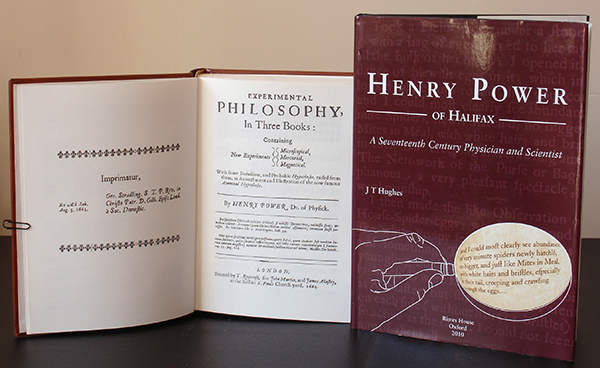
|
In 1665 Robert Hooke's 'Micrographia' was published—it describes common subjects as seen under the microscope and together with the large intricate engravings, the book had a huge impact at the time and continues to impress to this day. It wasn't quite the first book published in English on microscopy—Dr. Henry Power's was the first, albeit by only up to two years
before in 1663.
My own interest in Henry Power's life and work (as a microscopy enthusiast rather than historian) was piqued when I realised that he lived and worked at New Hall, Elland (later moving to Wakefield) which is just a few miles north of my own home in Huddersfield. Although Power and his microscopical work barely receives a mention in a number of accounts of the history of science and microscopy*, his life and
work has been thoroughly discussed by historians. A selection of the key resources that
have come across to date are summarised below and compiled in 'Resources'.
(*Henry Power in a microscopical context is perhaps better known for his poem 'In commendation of ye microscope'. See Resources, paper by Thomas Cowles. 1934 )
'Experimental Philosophy'
Power's single work was 'Experimental Philosophy, in Three Books: New Experiments. Microscopical, Mercurial, Magnetical'. These were bound together but are discrete books, each with their own title page. The 'Microscopical' book is 83 pages of 51 'Observations' of a range of common subjects with an extended Preface and deductions etc at the end. There are only three illustrations and these are crude compared with those in Hooke's 'Micrographia' where nearly all his Observations
are illustrated. See Appendix where I've tabulated the Observations for both Power and Hooke's respective books. A number of their subjects are the same and each refers to the other's work in their Prefaces.
Facsimiles of Power's book are available (see Resources) although surprisingly, it's not available to my knowledge online in the public domain. The key modern resource to learn of Power's life and work is undoubtedly Hughes 'Henry Power of Halifax', which is superb, extensively illustrated and with high reproduction standards. This covers his family life, his work as a physician and his scientific experiments,
including microscopical. Clay's and Hughes' papers in the 'Transactions of the Halifax Antiquarian Society' provide a rounded account of various aspects of Power's life.
A number of extensive essays or papers have been published which discuss in particular Power and his scientific work (see resources). Meghan Doherty's award winning essay in 2012 is a fascinating read which includes and discusses comparative drawings of poppy seeds made by both Power and Hooke. Cowles' paper (1934) and Webster's (1967) are both particularly valuable for the microscopy enthusiast like myself to fully appreciate how
Power's scientific studies should be placed in the context of his times and his relations with his contemporaries.
Henry Power's (and his friend Richard Towneley's) most noted scientific work were their studies of the relation between the pressure and volume of a gas which later became known as Boyle's Law (see Hughes and e.g. Wikipedia entry Boyle's Law). These experiments are discussed and illustrated (including a fold out plate) in the 'Mercurial' book
of Power's 'Experimental Philosophy'.
Appraisals of the value of Power's microscopical studies seems to vary somewhat between historians, some being rather dismissive others more positive. With access to affordable facsimile's of Power's work and free access copies online of 'Micrographia', the reader can form their own opinion. I thoroughly enjoyed reading Power's microscopical 'Observations'. Many are short, barely a paragraph, others are more extensive and running
to some pages. His skills in dissection are particularly evident with a number of small insects dissected to study their eyes or to view their heart beating after decapitation. What particularly appealed to me was his eloquent turn of phrase in many of his descriptions. A selection of my favourites are listed below.
|
Observation Number
|
Subject
|
Quote from Henry Power's 'Experimental Philosophy'
|
| XX |
'The Gloworm or Glassworm' |
'whereas the Coelestial Lights are quite obscured by the interposition of a small cloud, this Terrestial-Star is more enliven'd thereby, whose pleasant fulgour no darkness is able to eclipse.' |
| XXII |
'The Ant, Emmet, or Pissmire' |
'This little Animal is that great Pattern of Industry and Frugality ; To this Schoolmaster did Solomon send his Sluggard, who in those virtues not onely excels all Insects, but most men.' |
| XXXIII |
'Corns of Sand, Sugar, and Salt' |
'It is worth an Hour-glass of time to behold the Crystal Sands that measure it ; for they all seem like Fragments of Crystal, ...' |
| XLV |
'Of Nettles' |
'... and every needle hath a Crystal pummel, so that it looks like a Sword-Cutler's Shop, full of glittering drawn Swords, Tucks, and Daggers :' |
| XLVIII |
'A Line drawn upon Paper' |
'As these dioptrical Glasses, do heighten and illustrate the Works of Nature, so do they on the other side, disparage and depreciate those of Art.' |
Power was known to have microscopes made by Richard Reeves, a noted London scientific instrument maker at the time. A facsimile of a letter dated 1662 from Power to Reeves reproduced in Hughes book is particularly interesting. The improvements in the microscopes he desired and discussed were perceptive and relevant for any microscope today; working distance of objective, field of view, objective choice for different
subjects and the merits of a transparent subject plate for transmitted work.
New Hall Farm, Whitwell Green Lane, Elland, HX5 9PH near Halifax
At the time of writing, the current leaden skies over the Pennine Hills in mid-winter aren't ideal for photography so I am indebted to Humphrey Bolton who has shared some attractive images of the hall on the Geograph site taken in September 2006. They are shared here with his kind permission.
A detailed history and architectural details of New Hall are provided on the English Heritage website which notes that it was built in the 15th century.
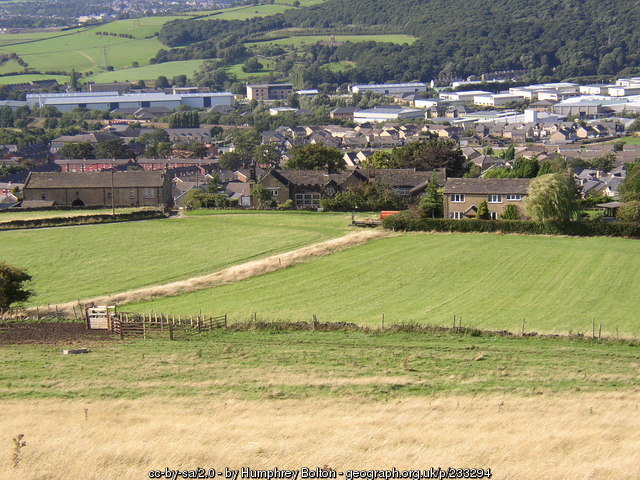
"Elland New Hall, off Dewsbury Road, Elland" © Copyright Humphrey Bolton and licensed for reuse under this Creative Commons Licence.
Power's residence is now New Hall Farm, Elland. It is shown in the centre. Its setting in Power's time would have been rural
before the modern encroachment of residential and industrial properties.
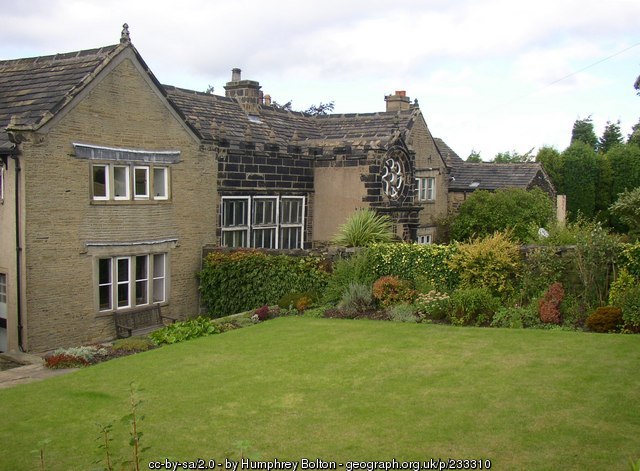
"South front of New Hall, off Dewsbury Road, Elland." © Copyright Humphrey Bolton and licensed for reuse under this Creative Commons Licence.
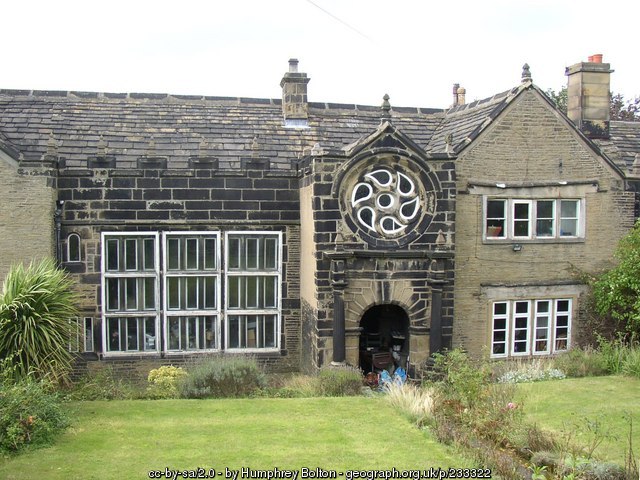
Hall and porch of New Hall, off Dewsbury Road, Elland. © Copyright Humphrey Bolton and licensed for reuse under this Creative Commons Licence.
Burial and memorial
Henry Power died aged ca. 42 and was buried at All Saints Church, Wakefield now Wakefield Cathedral. There's a fitting memorial to his life and work which is illustrated below. The inscription notes his microscopical work. It seems rather ironic that the original memorial to Power, a barely known figure compared with Hooke, remains to this day. This is in stark contrast to Robert Hooke who has no known extant grave or memorial, the reasons being described e.g in this Daily Telegraph article
in 2001 'Hunt is on for pauper grave of Isaac Newton's greatest rival'. Only in recent years, in part prompted by the tercentenary of Hooke's death in 2003, has this been remedied with the commissioning and installation of modern memorials (see Wikipedia
'List of new memorials to Robert Hooke 2005 - 2009' and www.roberthooke.org).
|
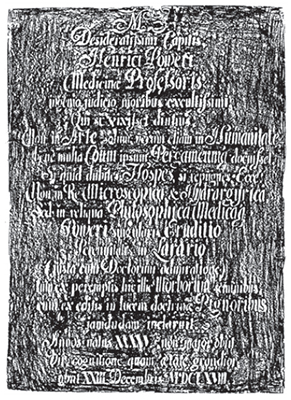
|
"M.S.
Desideratissimi Capitis,
Henrici Poweri,
Medicinæ Professoris
Ingenio, judicio, moribus excultissimi,
Qui, si vixisset diutius
Non in Arte solum, verum etiam in Humanitate
bene multa Coum ipsum, Pergameumq, docuisset
Si quid dubites, Hospes, si repugnes, Ecce !
Non in re Microscopica et Hydrargyrica,
Sed in reliqua Philosophica, Medicaq :
Poweri singularis Eruditio
Perennitatis in Larario
(justa cum Doctorum admiratione)
tum ex peremptis hie illie Morborum seminibus,
cum ex editis in lucem doctrinæ Pignoribus
jamdudum inclaruit.
Annos Natus XXXXV., non major obiit
Vir, cognitione quam ætate grandior.
Obiit XXIII. Decembris. MDCLXVIII."
|
"Sacred to the Memory
Of the beloved Henry Power, Professor of Medi-
cine, who died Dec. 23rd, 1668, aged 45 years.
He was a man of marked ability and character.
Had his life been prolonged he would not have merely
have surpassed even Cos [Hippocrates] and Per-
gamus [Galen] in professional knowledge, but in
general culture. Should you, stranger, be disposed
to discredit this panegyric, know that Power's
pre-eminence in learning had long been evidenced
as well as in other branches of philosophy and Medi-
cine, as in investigations with the microscope,
and the discovery of the properties of quick
silver. His name indeed will for ever be a house-
hold word, and will deservedly command the
respect of learned men.
Not merely in the destruction of the germs of
diseases has his reputation been achieved, but from
the evidences of his learning which have been
brought to light. His years were few, his learning great."
|
Above: Left - a modern brass rubbing by Patrick Farman of the brass plaque dedicated to Henry Power in All Saint's Church, Wakefield now Wakefield Cathedral. Used with thanks (see Acknowledgements).
Patrick Farman notes in the Bulletin of the Monumental Brass Society that it is a 'mural in the north choir aisle' and at the time of the rubbing awkward to access. Presumably it has been moved since 1917 when in Clay's paper, he notes and cites early commentators stating that it was a 'brass plate in the floor of the middle chancel'.
Centre - the Latin transcription as recorded by J W Clay in his 1917 paper 'Dr. Henry Power of New Hall, F.R.S.' (full. ref. below).
Right - the English translation by J W Clay in above paper. Presented here as formatted in the paper.
Comments to the compiler David Walker are welcomed.
Resources
Primary
'Experimental Philosophy, in Three Books: New Experiments. Microscopical, Mercurial, Magnetical.' by Henry Power, Dr. of Physick, London, 1664.
Known modern editions:
I have not yet found a copy in the public domain from sources such as www.archive.org or Google Books.
- 2009 Rimes House. Hardback. Photographic facsimile, copyright John Trevor Hughes. Folded plate at back. It notes in the preliminaries that although dated 1664, copies in 1663 were available. Available new but now expensive e.g. Amazon UK.
- 2011 EEBO Editions. Paperback. New and used from e.g. Amazon UK or Abe from £11 at time of writing. The quality of transcription is unknown but does state that the folded
plate is present
- 1966 Johnson Reprint Corporation, New York. Occasionally available from e.g. Abe. Out of print and typically expensive.
- EEBO web site 'Early English Books Online'. Available only to affiliated researchers via institutional login. Presumably the above EEBO paperback is a facsimile of this online edition.
Further primary sources - see the references in J H Hughes book below.
Secondary
- 'Power, Henry' entry in Oxford Dictionary of National Biography. Free access online with UK public library card number. A useful concise summary of his life and work.
- 'Henry Power of Halifax: A Seventeenth Century Physician and Scientist' by J T Hughes, Rimes House, Oxford, 2010, 119 pages. Hardback.
Excellent value, currently from £1.70 upwards used or new from Amazon UK Marketplace.
- 'Dr. Henry Power of New Hall, F.R.S.' by J W Clay, Papers, Reports, etc. read to the Halifax Antiquarian Society (now the Transactions of the Halifax Antiquarian Society), February 6th, 1917, 1 - 31.
- Halifax Antiquarian Society. The Transactions lists seven papers on Henry Power including the one by J W Clay. Three are by J T Hughes which his book may cover.
- 'Dr Henry Power, disciple of Sir Thomas Browne' by Thomas Cowles, Isis, 1934, vol.20 (2), 344-366.
- 'Henry Power's Experimental Philosophy' by C Webster, Ambix, 1967, 14, 150-178.
- 'Discovering the 'True Form:' Hooke's Micrographia and the Visual Vocabulary of Engraved Portraits' by Meghan C Doherty, Notes and Records of the Royal Society, 2012, 66, 211-264. Link is to free access online and pdf download.
- 'Dr. Henry Power's poem on the Microscope' by Thomas Cowles, Isis, 1934, vol.21 (1), April, 71-80.
Acknowledgements:
Thank you to David Glover, Publications Officer of the Halifax Antiquarian Society for providing a copy of the paper by J W Clay.
Thank you to Jon Bayliss and Patrick Farman for permission to use the brass rubbing of Henry Power's memorial in Wakefield Cathedral as presented on page 12 of the Bulletin 120, June 2012 of the Monumental Brass Society.
Any errors in the article are solely that by the author, David Walker.
Appendix List of 'Observations' from each of Dr. Henry Power's 'Experimental Philosophy' book 1 'Microscopical' and Robert Hooke's 'Micrographia'.
Compiled by David Walker, original spellings and capitalisation of subjects retained.
Henry Power's 'Experimental Philosophy'. Book one 'New Experiments Microscopical'
The Preface to the Ingenious READER. (20 pages)
Signed 'HENRY POWER From NEW HALL, near HALIFAX. 1. Aug. 1661.
Microscopical book 83 pages.'
| 'Observation'
| Title (Bold entry = illustrated)
| Type of Subject
|
| I
| Of the Flea
| Insect
|
| II
| The Bee
| Insect
|
| III
| The Common Fly
| Insect
|
| IV
| The Gray, or Horse-Fly
| Insect
|
| V
| The Butter-Fly
| Insect
|
| VI
| A Louse
| Insect
|
| VII
| A Wood-Louse, or Wood-Mite
| Crustacea
|
| VIII
| The House-Spider
| Arachnid
|
| IX
| The little white Field-Spider with short legs
| Arachnid
|
| X
| The Field-Spider with long legs
| Arachnid
|
| XI
| Another Field-Spider
| Arachnid
|
| XII
| Mites in Cheese
| Arachnid
|
| XIII
| Mites in Malt-dust and Oatmeal-dust
| Arachnid
|
| XIV
| Mites, bred amongst Figs
| Arachnid
|
| XV
| The Mites, in Jujubes and Sebesten's
| Arachnid
|
| XVI
| The red Mite, found on Spiders
| Arachnid
|
| XVII
| The Mites or Lice found on Humble-Bees
| Arachnid
|
| XVIII
| Pond-Mites
| Arachnid
|
XIX
| Whey-worms, called by some, Wheal-worms,
Or Hand-worms, or Barrows
| Arachnid
|
| XX
| The Gloworm or Glassworm
| Insect
|
| XXI
| Common Grasshoppers
| Insect
|
| XXII
| The Ant, Emmet or Pissmire
| Insect
|
| XXIII
| Of the little greenish Grasshopper or Locust …
| Insect
|
| XXIV
| The yellow Locust
| Insect
|
| XXV
| Of Cuckoo-Spitt, and the little Insect bred therein, in May
| Insect
|
| XXVI
| The Cow-Lady, or Spotted Scarabee
| Arachnid
|
| XXVII
| The Water-Insect, or Water-Spider
| Arachnid
|
| XXVIII
| The Wasp-like Locust
| Insect
|
| XXIX
| The Sycomore Locust
| Insect
|
| XXX
| Of the little white Eels or Snigs, in Vineger or Aleger
| Nematode
|
| XXXI
| Of the great Black Snail
| Mollusc
|
| XXXII
| Of Lampreys
| Fish
|
| XXXIII
| Corns of Sand, Sugar, and Salt
| Mineral, Chemical crystals
|
| XXXIV
| A Small Atom of Quick-Silver
| Chemical elements
|
| XXXV
| Mercurial Powders
| Chemical
|
XXXVI
| Of the seven Terrestial Planets, as the Chemysts call them.
Gold, Silver, Steele, Copper, Quick-Silver, tin, Lead
| Chemical elements
|
| XXXVII
| Ribbons of all sorts of Colours, Silk, Sateen, Silver and mixed
| Textiles
|
| XXXVIII
| The small Dust, Powder, or Seeds of the lesser Moon-wort
| Plants
|
| XXXIX
| The Seeds of Wall-Rue, or white Maydenhair
| Plants
|
| XL
| Of the Seeds of Strawberries
| Plant
|
| XLI
| Corn Poppy Seeds
| Plant
|
| XLII
| The small Dust Powder on the Pendents of Lilies
| Plant pollen
|
| XLIII
| The Leafs of several Trees and Plants
| Plants
|
| XLIV
| Pink-pendents
| Plant
|
| XLV
| Of Nettles
| Plant
|
| XLVI
| Gilla Theophrasti
| Chemical (Zinc sulphate)
|
| XLVII
| A Nitt
| Insect and eggs
|
| XLVIII
| A Line drawn upon Paper
| Paper
|
| XLIX
| The Sparks of Flint and Steel
| Worked metals
|
| L
| Of Hair
| Animal
|
| LI
| Of Aromatical, Electrical, and Magnetical Effluxions
| Physical
|
Three subjects illustrated.
*************************************************************************************
Robert Hooke's 'Micrographia'
Dedication and Preface (latter, 30 pages). Text 246 pages. Index.
With XXXVIII 'Schemes' (engraving plates, some with multiple figures).
| 'Observation'
|
Title All subjects illustrated except two, nos. XVI and XLVIII.
| Subject
|
| I
| Of the Point of a Sharp Small Needle
| Worked metals
|
| II
| Of the Edge of a Razor
| Worked metals
|
| III
| Of fine Lawn, or Linnen Cloth
| Textiles
|
| IV
| Of fine waled Silk, or Taffety
| Textiles
|
| V
| Of watered Silks, or Stuffs
| Textiles
|
| VI
| Of small Glass Canes
| Optics
|
| VII
| Of some Phaenomena of Glass drops
| Optics
|
| VIII
| Of the fiery Sparks struck from a Flint or Steel
| Worked metals
|
| IX
| Of the Colours observable in Muscovy Glass, and other thin Bodies
| Optics
|
| X
| Of Metalline, and other real Colours
| Optics
|
| XI
| Of Figures observ'd in small Sand
| Mineral
|
| XII
| Of Gravel in Urine
| Chemical crystals
|
| XIII
| Of the small Diamants, or Sparks in Flints
| Worked metals
|
| XIV
| Of several kindes of frozen Figures
| Ice crystals
|
| XV
| Of Kettering-stone, and the pores of Inanimate bodies
| Mineral
|
| XVI
| Of charcoal, or burnt Vegetables
| Plant
|
| XVII
| Of Petrify'd wood, and other Petrify'd bodies
| Plant
|
XVIII
| Of the Schematisme or Texture of Cork, and of the Cells and Pores
Of some other such frothy Bodies
| Plant
|
XIX
| Of a Plant growing in the blighted or yellow specks of Damask-rose-leaves,
Bramble-leaves, and some other kind of leaves
| Plant
|
| XX
| Of blue Mould, and of the first Principles of Vegetation arising from Putrefaction
| Fungi
|
| XXI
| Of Moss, and several other small vegetative Substances
| Plant moss
|
| XXII
| Of common Sponges, and several other Spongie fibrous bodies
| Marine sponge
|
| XXIII
| Of the curious texture of Sea-weeds
| Marine algae
|
| XXIV
| Of the surfaces of Rosemary, and other leaves
| Plant
|
| XXV
| Of the stinging points and juice of Nettles, and some other venomous Plants
| Plant
|
| XXVI
| Of Cowage, and the itching of some bodies
| Plant?
|
XXVII
| Of the Beard of a wilde Oat, and the use that may be made of it for exhibiting
always to the Eye The temperature of the Air, as to driness and moisture
| Plant
|
| XXVIII
| Of the Seeds of Venus looking-glass, or Corn Violet
| Plant
|
| XXIX
| Of the Seeds of Tyme
| Plant
|
| XXX
| Of the Seeds of Poppy
| Plant
|
| XXXI
| Of Purslane-seed
| Plant
|
| XXXII
| Of the Figure of several sorts of Hair, an of the texture of the Skin
| Animal
|
| XXXIII
| Of the Scales of a Soal, and other Fishes
| Fish
|
| XXXIV
| Of the Sting of a Bee
| Insect
|
| XXXV
| Of the contexture and shape of the particles of Feathers
| Bird
|
| XXXVI
| Of Peacoks, Ducks, and other Feathers of changeable colours
| Bird, optics
|
| XXXVII
| of the Feet of Flies, and several other Insects
| Insect
|
| XXXVIII
| Of the Structure and motion of the Wings of Flies
| Insect
|
| XXXIX
| Of the Eyes and Head of a Grey drone-Fly, and of several other creatures
| Insect
|
| XL
| Of the Teeth of a Snail
| Mollusc
|
| XLI
| Of the Eggs of Silk-worms, and other Insects
| Insect
|
| XLII
| Of a blue Fly
| Insect
|
| XLIII
| Of the Water-Insect or Gnat
| Insect
|
| XLIV
| Of the tufted or Brush-born'd Gnat
| Insect
|
| XLV
| Of the great Belly'd Gnat or female Gnat
| Insect
|
| XLVI
| Of the white featherwing'd Moth or Tinea Argentea
| Insect
|
| XLVII
| Of the Shepherd Spider, or long legg'd Spider
| Arachnid Spider
|
| XLVIII
| Of the hunting Spider, and several other Sorts of Spiders
| Arachnid Spider
|
| XLIX
| Of an Ant or Pismire
| Insect
|
| L
| Of the wandring Mite
| Insect
|
| LI
| Of the Crab-like Insect
| Insect
|
| LII
| Of the small Silver-colour'd Book-worm
| Insect
|
| LIII
| Of a Flea
| Insect
|
| LIV
| Of a Louse
| Insect
|
| LV
| Of Mites
| Arachnid Mite
|
| LVI
| Of a small Creature on a Vine
| Insect?
|
| LVII
| Of the Eels in Vinegar
| Nematode
|
LVIII
| Of a new Property in the Air, and several other transparent Mediums nam'd Inflection,
whereby many considerable Phaenomena are attempted to be solv'd, and divers
Other uses are hinted
| Physics
|
| LIX
| Of multitudes of small Stars discoverable by the Telescope
| Astronomy
|
| LX
| Of the Moon
| Astronomy
|
First published April 13th 2015
Minor revisions April 15th and 16th 2015
©
Microscopy UK or their contributors.
Published
in the April 2015 edition of Micscape.
Please
report any Web problems or offer general comments to the
Micscape
Editor .
Micscape
is the on-line monthly magazine of the Microscopy UK web site at
Microscopy-UK
© Onview.net
Ltd, Microscopy-UK, and all contributors 1995 onwards. All rights
reserved.
Main site is at www.microscopy-uk.org.uk
with full mirror at
www.microscopy-uk.net
.




